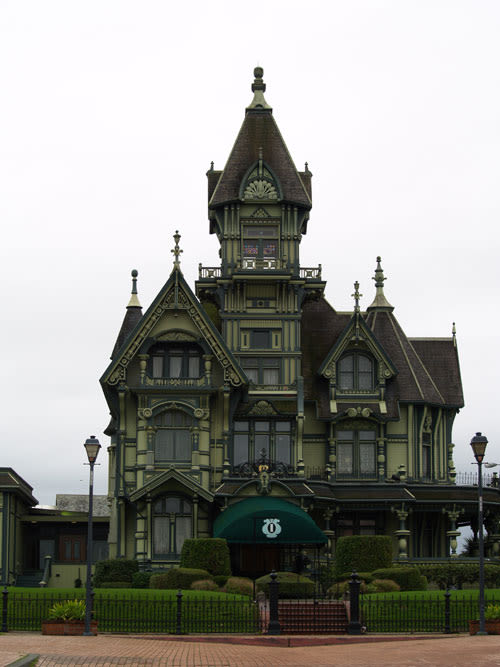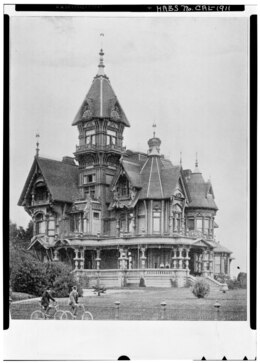The Carson Mansion is a large Victorian house located in Old Town, Eureka, California. Regarded as one of the premier examples of Queen Anne style architecture in the United States, the house is “considered the most grand Victorian home in America.” It is one of the most written about and photographed Victorian houses in California and possibly also in the United States.
The Carson Mansion is an iconic Victorian house located in Old Town, Eureka, California. Built in 1884-1886 by lumber baron William Carson, it is one of the most photographed Victorian houses in the United States. The mansion features a mix of architectural styles, including Queen Anne, Gothic Revival, and Eastlake, making it a prime example of the opulent and eclectic designs of the period. Today, it is a private club and not open to the public, but its exterior remains a popular attraction for visitors and architecture enthusiasts.

The Carson Mansion is a large Victorian house located in Old Town, Eureka, California. Regarded as one of the premier examples of Queen Anne style architecture in the United States, the house is “considered the most grand Victorian home in America.” It is one of the most written about and photographed Victorian houses in California and possibly also in the United States.
About
Originally the home of William Carson, one of Northern California’s first major lumber barons, it has been a private club since 1950. The house and grounds are not open to the public. It is owned and occupied by the private Ingomar Club.
Carson family history
William Coleman Carson (July 15, 1825 New Brunswick – February 20, 1912 Eureka), for whom the house was built, arrived in San Francisco from New Brunswick, Canada, with a group of other woodsmen in 1849. After rolling out gold slugs in San Francisco, they joined in the northern gold rush, arriving in the Trinity Mountains via the Eel River and Humboldt Bay. They left the Trinity Mountains to overwinter at Humboldt Bay and contracted to provide logs for a small sawmill. In November 1850, Carson and Jerry Whitmore felled a tree, the first for commercial purposes on Humboldt Bay. All winter, Carson and his team hauled logs from the Freshwater Slough to the Pioneer Mill on the shores of Humboldt Bay.
In spring, the party went back to the mines where they had previously staked claim on Big Bar by the Trinity River. They built a dam and continued mining until they heard that a large sawmill was being built at Humboldt Bay. They went south through the Sacramento Valley, bought oxen, and returned to Humboldt Bay by August 1852, where Carson, alone, went into the lumber business permanently. In 1854, he shipped the first loads of redwood timber to San Francisco. Previously, only fir and spruce had been logged.
In 1863, Carson and John Dolbeer formed the Dolbeer and Carson Lumber Company. Eighteen years later, in 1881, as the company advanced into areas more difficult to log, Dolbeer invented the Steam Donkey Engine which revolutionized log removal, especially in hard-to-reach areas. At about the same time, Carson was involved in the founding of the Eel River and Eureka Railroad with John Vance. Before commencing the building of his mansion, Carson said, “If I build it poorly, they would say that I am a damned miser; if I build it expensively, they will say I’m a show off; guess I’ll just build it to suit myself.” In 1884, on the eve of construction of the great home, the company was producing 15,000,000 board feet (35,000 m3) of lumber annually. The milling operations, combined with additional investments as far away as Southern California and at least partial ownerships in schooners used to move the lumber to booming markets on the west coast and all over the globe, set the stage for the seemingly unlimited budget and access to resources. Pacific Lumber Company purchased the company in 1950 and maintained milling operations at the original Humboldt Bay site, located bay-side below the house, well into the 1970s. Following the Carson family divestiture of remaining family holdings (including the home) in 1950, the family left the area.
The building was purchased for $35,000 in 1950 by local community business leaders, and now houses the Ingomar Club, a private club, which was named after Carson’s Ingomar Theater, itself named for Carson’s favorite play, Ingomar the Barbarian.
Architecture
The house is a mix of every major style of Victorian architecture, including but not limited to: Eastlake, Italianate, Queen Anne (primary), and Stick. One nationally known architectural historian described the house as “a baronial castle in Redwood…” and stated further that “The illusion of grandeur in the house is heightened by the play on scale, the use of fanciful detail and the handling of mass as separate volumes, topped by a lively roofscape.” The style of the house has been described as “eclectic” and “peculiarly American.” The building has always been maintained and is in nearly the same condition as when it was built.
In May 1964, the house was included in the Historic American Buildings Survey (HABS) as catalog number CA-1911. This is the only official historical building listing of the house. Although the historic house does merit National Register of Historic Places status, the Ingomar Club has chosen not to apply for it.
Architects

Samuel Newsom and Joseph Cather Newsom of the firm Newsom and Newsom of San Francisco (and later Los Angeles and Oakland) were nineteenth century builder-architects contracted by Carson to create the house by 1883. Of their many commissions in California, many of the original buildings remain in addition to the Carson house, including the Napa Valley Opera House and the San Dimas Hotel.
One Queen Anne style Victorian house they designed in Eureka was named “The Pink Lady,” which William Carson gifted to his son Milton as a wedding present in 1889. After being sold in 1920, it went through several owners before being inherited by sisters in Germany. It operated as a rooming house until it was seized as Nazi property in 1942. In 1964, it became the first historic building in Eureka to be restored. Another of their Queen Anne style designs was built in Eureka in 1982 as the Carter House Inn. It is a replica of the 1885 Murphy House in San Francisco, designed by Newsom and Newsom, which was lost in the 1906 San Francisco earthquake.
In popular culture
Images of the house are prevalent in website designs and video animations as well as on posters, paintings, and book covers. This popularity also has led to replicas being created in amusement parks, including the clock tower on the train station at Disneyland. The home also serves as a model for haunted house artwork and design.
Nestled in the heart of Old Town, Eureka, California, the Carson Mansion stands as a testament to a bygone era of opulence and grandeur. This stunning Victorian masterpiece, often hailed as one of the most photographed houses in the United States, beckons admirers from all corners of the globe to marvel at its intricate design and storied history.
A Jewel of Victorian Architecture
Constructed between 1884 and 1886 by the illustrious lumber baron William Carson, the mansion is a mesmerizing blend of Queen Anne, Gothic Revival, and Eastlake styles. Its elaborate exterior, adorned with intricate woodwork, turrets, and stained glass windows, is a feast for the eyes and a perfect embodiment of the Victorian era’s architectural exuberance. Every detail, from the ornate trim to the sweeping verandas, showcases the craftsmanship and artistic vision that went into its creation.
A Storied Past
The Carson Mansion is more than just a beautiful structure; it is a piece of history. William Carson, a key figure in California’s booming lumber industry, built this grand residence as a symbol of his success and prosperity. Over the years, the mansion has witnessed the ebb and flow of time, standing as a silent witness to the growth and transformation of Eureka.
Exclusive Elegance
Today, the Carson Mansion serves as the home of the Ingomar Club, a private club that maintains the property and preserves its historical integrity. While the mansion is not open to the general public, its exterior alone is worth the visit. The sight of its striking silhouette against the backdrop of Eureka’s charming Old Town is an experience that transports visitors to a different era.
A Photographer’s Dream
For photography enthusiasts, the Carson Mansion offers a wealth of opportunities to capture its intricate details and grand presence. Whether bathed in the golden light of sunrise or silhouetted against a dramatic sunset, the mansion’s architectural beauty is a captivating subject that never fails to inspire.
Visiting Eureka
A visit to the Carson Mansion is a highlight of any trip to Eureka, a city rich in history and culture. Strolling through Old Town, with its well-preserved Victorian buildings and vibrant arts scene, offers a delightful glimpse into the past. Nearby, the Humboldt Bay provides a scenic backdrop for leisurely walks and outdoor activities.
A Timeless Treasure
The Carson Mansion is more than just a building; it is a timeless treasure that encapsulates the spirit of an era marked by elegance and grandeur. Its enduring beauty and historical significance make it a must-see for anyone visiting Northern California. Whether you are an architecture enthusiast, a history buff, or simply someone who appreciates the finer things in life, the Carson Mansion is sure to leave a lasting impression.
Come and discover the Carson Mansion, where history and beauty converge in a stunning display of Victorian splendor.
